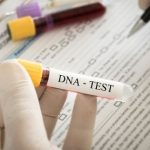Back in the 1700s, the best way to determine who a persons father was, was by taking a good hard look at the child, followed by a good hard look at the father. If there were enough coincidences then maybe a relationship could be possible. by the 1800s, it was discovered that eye color could be a paternity identifier. With recent DNA advances we have learned that the eye color theory is flawed. We now know that eye color is determined by at least six different alleles, or genetic markers. Fortunately paternity testing has become a lot easier and much more affordable over the past few years due to advances in DNA science.
Although an estimated 200,000 DNA tests are conducted each year by states needing to determine child-support and welfare issues, not as many people are willing to conduct their own at-home paternity test because they don’t realize the simplicity and convenience of an at-home paternity test.
How does home DNA testing work?
Paternity testing requires a painless sample from both the child and possible father. Even without a sample from the mother, DNA paternity test results are up to 99.9% accurate. Most companies provide testing material which they will mail directly to you so that you can provide the samples.
Because of advances in DNA testing it is no longer necessary to draw blood. Buccal (mouth) swabs are the standard. These swabs have the same genetic information that is carried in blood but none of the hazards. By gently massaging the inside of the child’s mouth, cheek cells are collected. These cells are then sent to the lab for testing. Labs analyze up to sixteen genetic markers of the child and match them against the markers of the alleged father. Because each of us receives half our genetic markers from each parent, the results of DNA paternity testing are still accurate without the DNA information of the mother but a really good test will include the mother this helps insure that there is no chance of a false positive.
What else can a DNA test do?
DNA test kits can also be used to analyze sibling relationships, establish cousin or grandparent relationships, determine twin zygosity (i.e. whether twins are fraternal or identical), identify ancestral origin, verify Native American decent, assure parents they left the hospital with the right baby, and most important, provide legal evidence – be prepared to pay a bit more for legal tests. Legal tests can be used to settle adoption issues, settle child-support disputes, and provide information for immigration files. Legal tests can not be preformed using a home test kit.
How to choose a DNA laboratory
- Accreditation is a vital part of choosing a laboratory. Accredited labs have an annual audit and inspection, undergo internal and external reviews, and have their equipment calibrated for accuracy. Look for an ISO and/or AABB certification. Accredited labs will have a good reputation and near 100% track record for court cases.
- Make sure you understand all the fees. Keep an eye out for hidden fees. Some companies will charge you for the kit and then charge you again for the results. This is especially true of kits purchased at a pharmacy or store.
- Double check when you order your kit that you’re only buying the results you need. If you need a test for any official purpose (changing a name or birth certificate) Make sure you are getting a legal test.
- Ask about privacy. Make sure that your identity and intentions are kept secure.
Enjoy piece of mind. Be confident that the questions you have can be answered and that DNA testing is safe easy and stress-free.




